2012 TC4 Gallery
Recovery Image
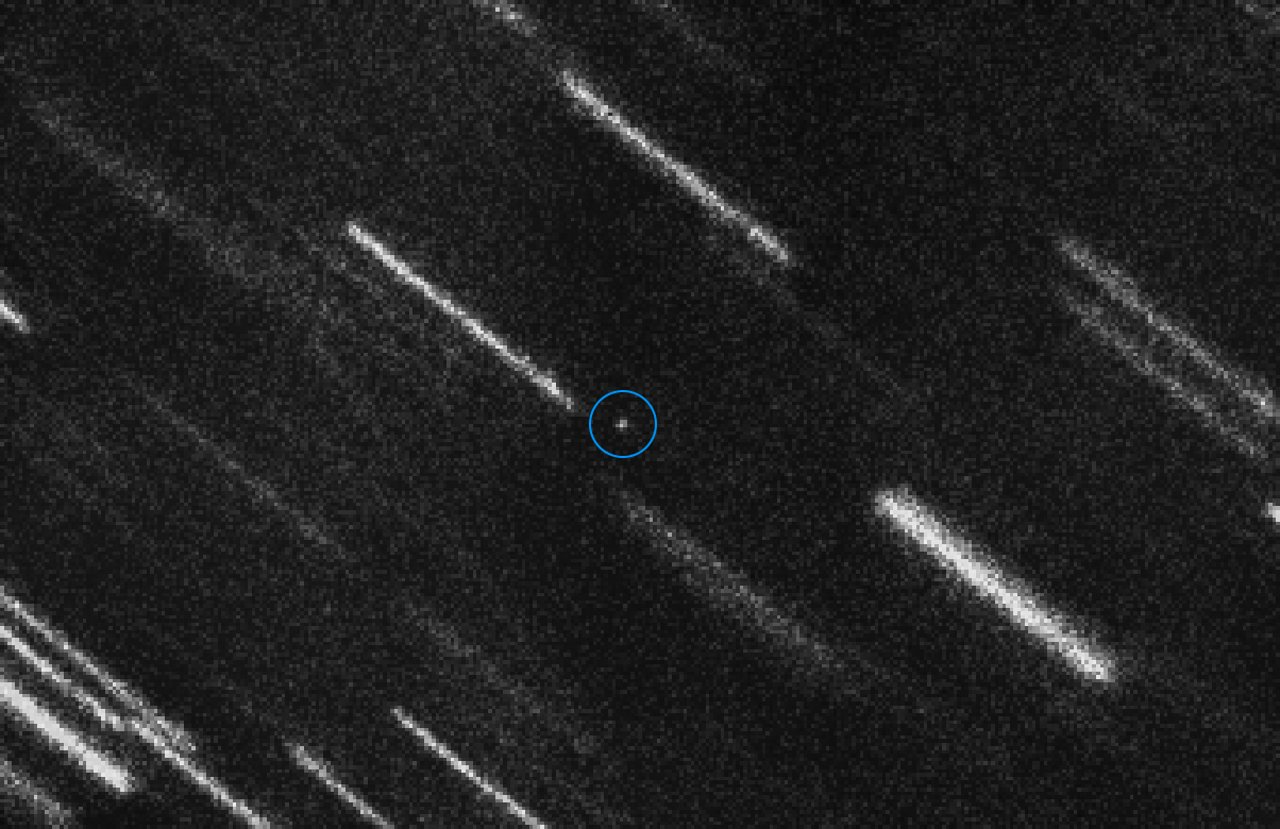 Details: 2012 TC4 observed (annotated)
Details: 2012 TC4 observed (annotated)
Credit: ESO / ESA NEOCC / Olivier Hainaut (ESO), Marco Micheli (ESA) and Detlef Koschny (ESA)
Related releases:
ASTEROID 2012 TC4 WILL FLY PAST EARTH IN OCTOBER 2017
A Very Close Encounter
Images and Movies
Animations posted to various sites on Facebook have been shared (collected) to the PDS-SBN Facebook page
FB images
FB videos2012 TC4 was observed at Kiso observatory in Japan on Oct. 10 and 11 by using a newly developed CMOS camera: see the movie here
2012 TC4 was observed by the Canadian space telescope NEOSSAT with details posted on their blog.
2012 TC4 Movies
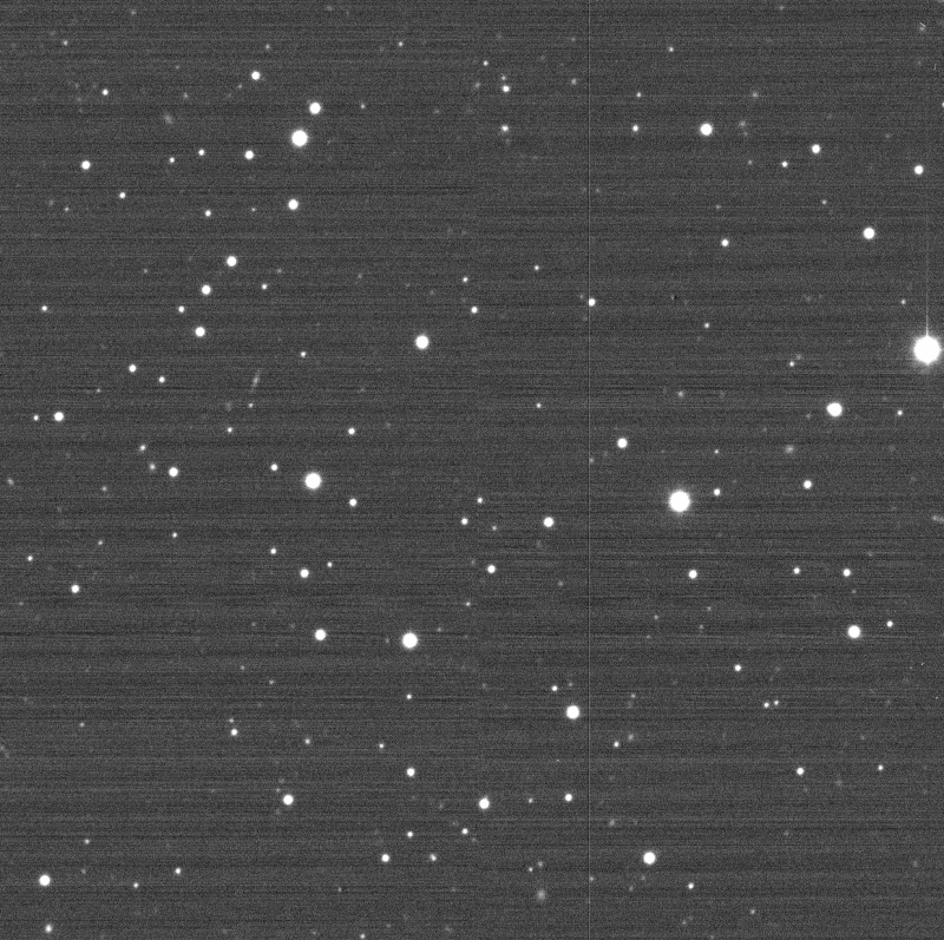
Date: 2017-10-09
Time: 20:07:40 - 20:47:19 UT
Telescope: KMTNet-SAAO 1.6m + 18K mosaic CCD
Exposure: 11 × 20s
Filter: R-band
Solar Phase Angle: 32°.1516
2012TC4-DEEP-South.pptx
Prepared by: Dong-Heun Kim
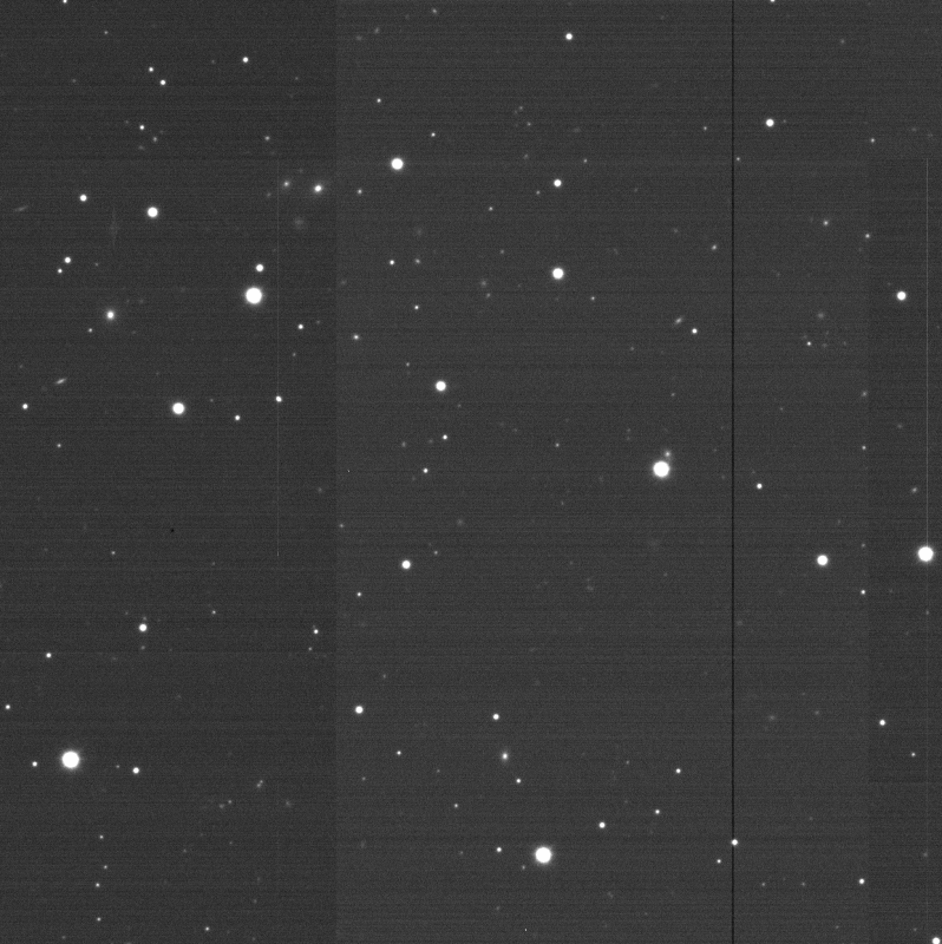
Date: 2017-10-10
Time: 11:13:07 - 14:21:06 UT
Telescope: KMTNet-SSO 1.6m + 18K mosaic CCD
Exposure: 12 × 15s
Filter: R-band
Solar Phase Angle: 33°.8334
2012TC4-DEEP-South.pptx
Prepared by: Dong-Heun Kim
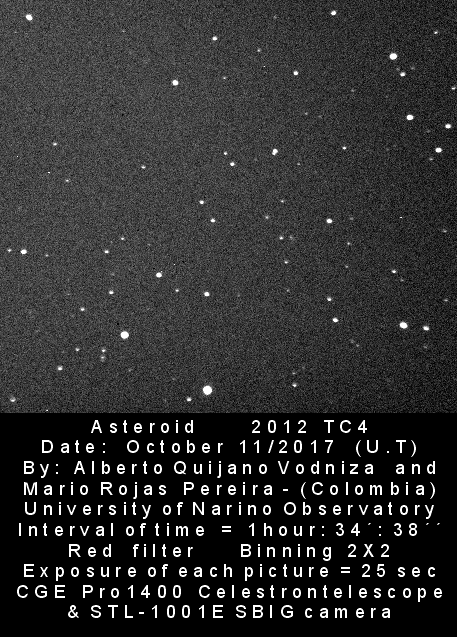
Details: 2012 TC4 moving across the sky on Oct 11, 2017
Credit: Alberto Quijano Vodniza and Mario Rojas Pereira, University of Narino Observatory, Colombia
As the asteroid traverses from upper right to lower left, it can be seen getting brighter and fainter, exhibiting its short primary rotation rate.
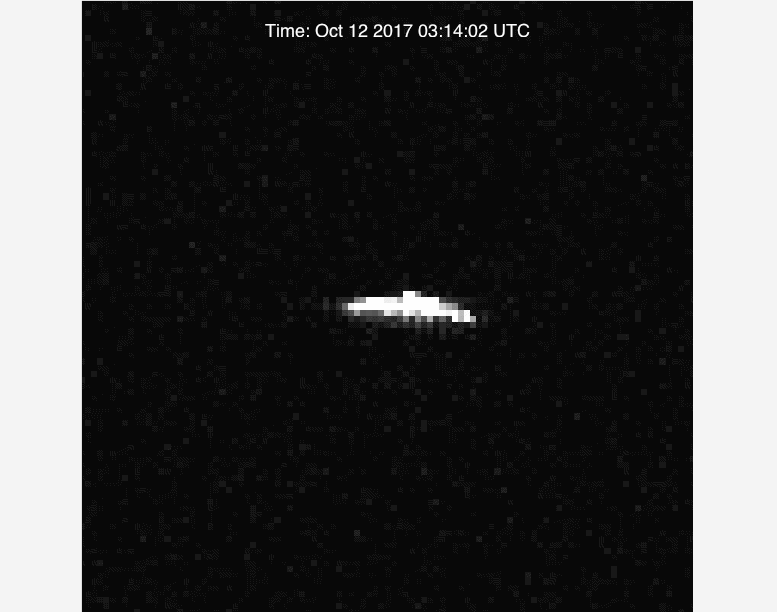

Details: Radar Echoes of 2012 TC4
Credit: DSS-13/GBT/JPL/Caltech/NASA
Two sequences of delay-Doppler images from October 12 obtained with DSS-13 (Goldstone's 34 m antenna) transmitting and the Green Bank Telescope (GBT) receiving. The short sequence, 03:14-03:23 UTC was obtained just prior to the 2012 TC4 close approach, while the long sequence, 13:09-19:00 UTC was obtained after the close approach. Time delay (range) increases from top to bottom and Doppler frequency increases from left to right. The range resolution is 1.875 m and Doppler frequency resolution is 0.2 Hz. The vertical dimension of each image is 187.5 m and the horizontal dimension is 20 Hz. Labels contain the start times of 20s data integration.
Assuming ~12 min rotation period, each delay-Doppler image averages ~10 deg of the object's rotation. The echo drifts from top to bottom in the long sequence because of a small Doppler error (<0.1 Hz) in the orbital predicts for 2012 TC4.
.avi
.avi
Animation of Radar Observations
Details: Animation of Radar Observations
Credit: M.Brozovic/JPL/Caltech/NASA
An animation showing radar observations on October 12. Goldstone's DSS-13 antenna was transmitting and Green Bank Telescope (GBT) was receiving. The radar data were collected shortly before the closest approach and then again when 2012 TC4 was on its outbound trajectory. The colored beams are on for the exact duration of radar observations.
Various Animations of 2012 TC4 Flyby using s56 (JPL orbital solution 56)
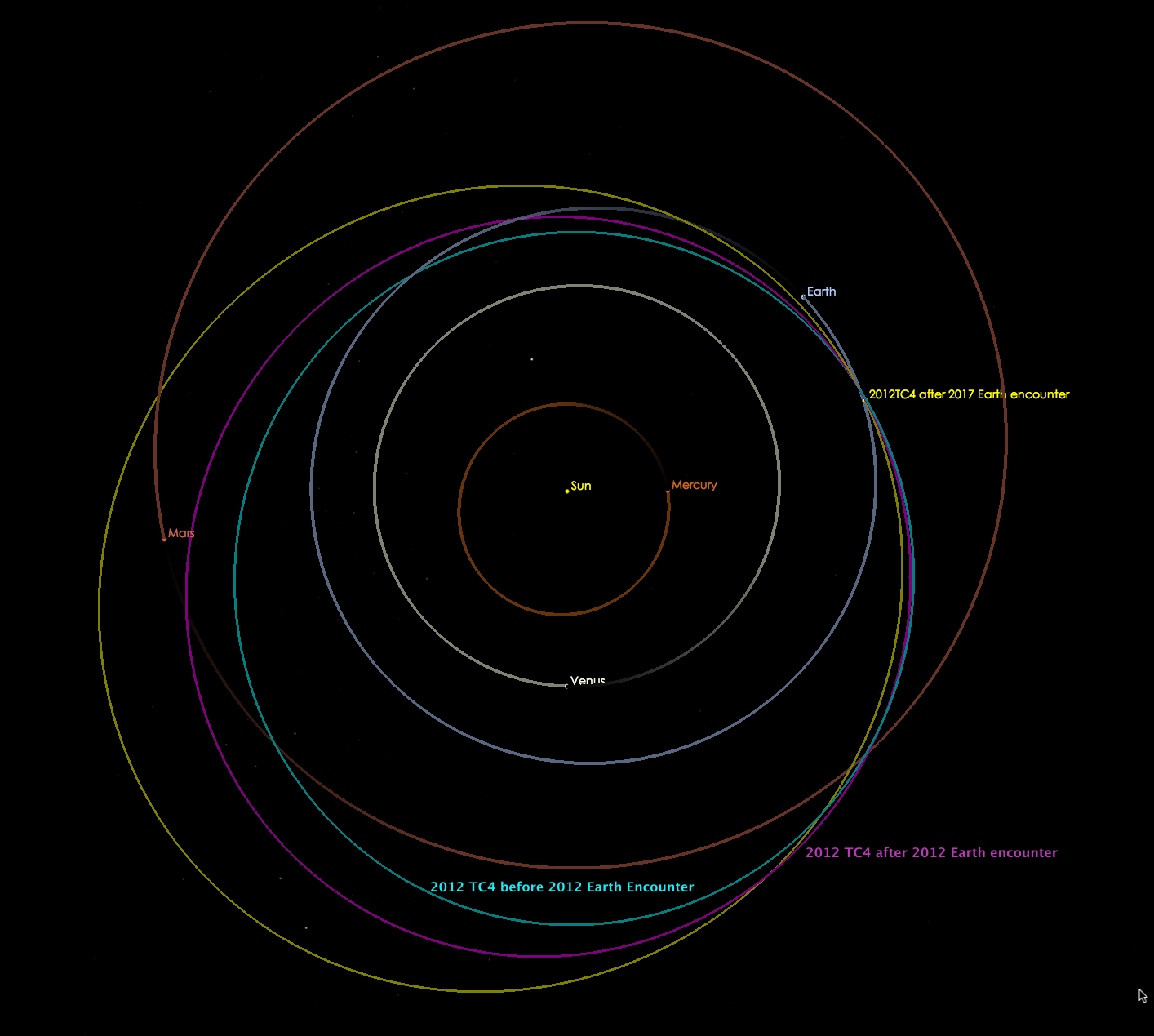 With a post-encounter orbital solution in hand, a team at JPL recreated the 2012 TC4 flyby using Cosmographia. The following animations show several different perspectives.
With a post-encounter orbital solution in hand, a team at JPL recreated the 2012 TC4 flyby using Cosmographia. The following animations show several different perspectives.
Credit: M.Brozovic/JPL/Caltech/NASA
Details: TC4_orbit_change.mov
2012 TC4's heliocentric orbit has changed due to the 2012 and 2017 close encounters with Earth. The cyan color shows the trajectory before the 2012 flyby, the magenta shows the trajectory after the 2012 flyby, and yellow shows the trajectory after the 2017 flyby. The orbital changes were primarily in semi-major axis and eccentricity, although there were also slight changes in the inclination.
TC4_orbit_change_topview.tiff
Credit: M.Brozovic/JPL/Caltech/NASA
Details: TC4_Earth_groundtrack.mov
Projection of 2012 TC4 orbit on Earth's surface during October 12 close approach. The red dots mark 300s intervals of the asteroid's ground-track. Their size is proportional to TC4's distance from Earth. A small white dot marks the sub-Earth point at the time of the closest approach. This point is off the southern coast of Australia, west of Tasmania.
Credit: M.Brozovic/JPL/Caltech/NASA
Details: TC4_orbit_bend.mov
Earth's gravity field bends the orbit of 2012 TC4 due to an exceptionally close flyby at 7.9 Earth's radii from the geocenter. This is a view of the TC4 orbit as seen by an observer on Earth.
Credit: M.Brozovic/JPL/Caltech/NASA
Details: TC4_flyby_space1.mov
2012 TC4 flyby of Earth on October 12. The asteroid approaches from the night-side and it quickly becomes a day-time object after the closest approach. The grey line marks the Moon's orbit. The red dots mark the localized areas of the Earth's surface closest to the asteroid at each time step (so-called sub-Earth points). The sub-Earth point marked in white represents time of the closest approach. This point is off the southern coast of Australia, west of Tasmania. The asteroid appears large with respect to Earth because of the camera position. Asteroid's mock-up shape model was scaled to be only 15 m in diameter.
Credit: M.Brozovic/JPL/Caltech/NASA
Details: TC4_Earth_satellites.mov
2012 TC4 flyby of Earth on October 12 with respect to Earth's artificial satellites. Not all satellites are shown in this animation. The cyan colored ring of objects are geostationary satellites. 2012 TC4 flyby at 7.9 Earth's radii from the geocenter was well outside the geosync ring. The asteroid appears large with respect to Earth because of the camera position. Asteroid's mock-up shape model was scaled to be only 15 m in diameter. The camera view is centered on the asteroid and it tracks Earth. 2012 TC4 was in the southern declinations during the closest approach.
Credit: M.Brozovic/JPL/Caltech/NASA
Details: TC4_Earth _satellites_synodic.mov
2012 TC4 flyby of Earth on October 12 with respect to Earth's artificial satellites. Not all satellites are shown in this animation. The cyan colored ring of objects are geostationary satellites. 2012 TC4 flyby at 7.9 Earth's radii from the geocenter was well outside the geosync ring. The asteroid appears large with respect to Earth because of the camera position. Asteroid's mock-up shape model was scaled to be only 15 m in diameter. The camera view is locked with respect to the stars (so-called synodic view). 2012 TC4 was in southern declinations during the closest approach.
Credit: M.Brozovic/JPL/Caltech/NASA